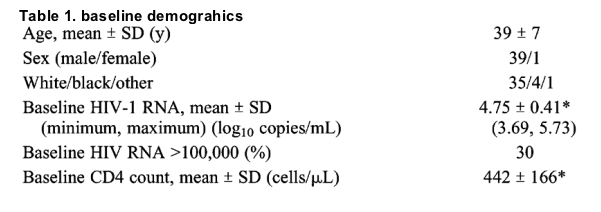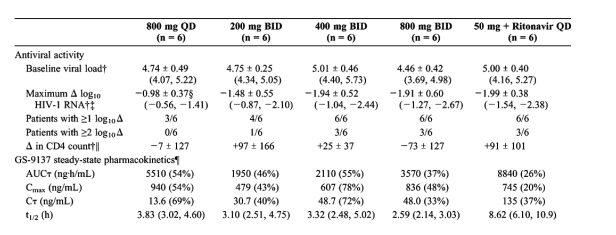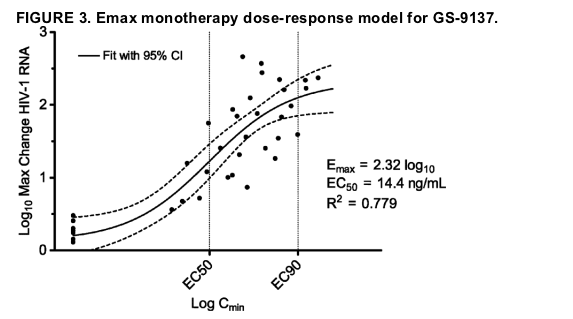| |
Antiviral Activity, Pharmacokinetics, and Dose Response of the HIV-1 Integrase Inhibitor GS-9137 (JTK-303) in Treatment-Naive and Treatment-Experienced Patients
|
| |
| |
JAIDS Journal of Acquired Immune Deficiency Syndromes: Volume 43(1) September 2006 pp 1-5
[Rapid Communication]
....10-day monotherapy study....Maximum delta log10 HIV RNA change: -1.99 for 50mg+RTV qd; -1.91 for 800mg bid; -1.94 for 400mg bid; -1.48 for 400mg bid; -0.98 for 800mg qd. 3/6 patients receiving highest doses achieved 2 log or more reductions.....Once-daily coadministration of GS-9137 with ritonavir boosts trough concentrations to those unachievable with twice-daily dosing of GS-9137 alone and may minimize the frequency and/or duration of suboptimal drug exposures caused by PK variability and late or missed doses.... The safety and efficacy of GS-9137 with ritonavir is currently under evaluation in a phase II study in combination with other antiretroviral agents in treatment-experienced patients....
authors: DeJesus, Edwin MD*; Berger, Daniel MD ; Markowitz, Martin MD ; Cohen, Calvin MD ; Hawkins, Trevor MD ; Ruane, Peter MD ; Elion, Richard MD#; Farthing, Charles MD**; Zhong, Lijie PhD ; Cheng, Andrew K. MD, PhD ; McColl, Damian PhD ; Kearney, Brian P. PharmD ; for the 183-0101 Study Team
From the *Orlando Immunology Center, Orlando, FL; NorthStar Medical Center, Chicago, IL; The Aaron Diamond AIDS Research Center, Rockefeller University, New York, NY; Community Research Initiative of New England, Boston, MA; Southwest Comprehensive AIDS-Care, Research & Education, Santa Fe, NM; Light Source Medical, Los Angeles, CA; #Clinical Alliance for Research and Education-Infectious Diseases, Washington, DC; **AIDS Healthcare Foundation Research Center, Beverly Hills, CA; and Gilead Sciences, Foster City, CA.
Abstract
Background: GS-9137 is a potent low-nanomolar strand transfer inhibitor of HIV-1 integrase.
Methods: The antiviral activity, tolerability, pharmacokinetics, and pharmacodynamics of GS-9137 were evaluated in a randomized, double-blind, placebo-controlled monotherapy study in 40 HIV-1- infected patients not receiving antiretroviral therapy with an HIV-1 RNA between 10,000 and 300,000 copies/mL and a CD4 count of 200 cells/mL or greater. GS-9137 or matching placebo was administered with food for 10 days at 5 dosage regimens (200, 400, or 800 mg BID, 800 mg QD, or 50 mg + 100 mg ritonavir QD; 6 active, 2 placebo per dose level). The primary end point was the maximum reduction from baseline in log10 HIV-1 RNA.
Results:
Forty patients were enrolled, with a mean baseline viral load of 4.75 log10 copies/mL and a CD4 count of 442 cells/mL.
Each GS-9137 dosing regimen exhibited significant, exposure-dependent (mean reductions, -0.98 to -1.99 log10 copies/mL) antiviral activity compared with placebo (P < 0.01).
Twice-daily administrations of GS-9137 at doses of 400 or 800 mg or once-daily dosing of 50 mg with ritonavir demonstrated mean reductions from baseline in HIV-1 RNA of 1.91 log10 copies/mL or greater, with all patients exhibiting 1 log10 or greater and 50% having 2 log10 or greater reductions.
No patient developed evidence of integrase resistance. GS-9137 showed an adverse event profile similar to placebo, and there were no study drug discontinuations.
Conclusions: GS-9137 demonstrated substantial short-term antiviral activity and was well tolerated as monotherapy, thus warranting further study.
RESULTS
Subject Disposition
Forty patients were enrolled; demographics presented by cohort and for the study overall are presented in Table 1. Although study inclusion/exclusion criteria did not preclude any demographic characteristic from participation, including female sex, all but one study subject were men. All patients completed the 10-day dosing period and the 21 total days of study evaluations.

Antiviral Activity
All GS-9137 dose cohorts exhibited substantial antiviral activity versus placebo (P < 0.001, ANOVA); mean ± SD results are shown in Table 2. Change from baseline in HIV-1 RNA with time is presented in Figure 2. Twice-daily administrations of GS-9137 at doses of 400 or 800 mg or once-daily dosing of 50 mg with ritonavir exhibited potent antiviral activity with mean reductions in HIV-1 RNA of 1.91 log10 copies/mL or greater; all patients achieved declines of 1.0 log10 copies/mL or greater, and 50% of the patients exhibited reductions of 2.0 log10 copies/mL or greater from the baseline.
Maximum reductions in HIV-1 RNA were observed on days 10 or 11 in all but 1 patient. A statistically significant difference in antiviral activity between GS-9137 dosage cohorts was seen in the -0.98 log10 response of the cohort with a dosage of 800 mg QD compared with those of the cohorts with dosages of 400 and 800 mg BID and 50 mg QD plus ritonavir (P < 0.02). As noted in other short-term monotherapy studies, no statistically significant changes in CD4 cell counts from baseline were observed in this 10-day study.12-15
Maximum delta log10 HIV RNA change: -1.99 for 50mg+RTV qd; -1.91 for 800mg bid; -1.94 for 400mg bid; -1.48 for 400mg bid; -0.98 for 800mg qd. 3/6 patients receiving highest doses achieved 2 log or more reductions.

Pharmacokinetics and Pharmacodynamics
Primary steady-state PK parameters of GS-9137 are presented in Table 2. GS-9137 exhibited a median Tmax of 3 to 4 hours upon single or multiple doses and an elimination t1/2 of approximately 3 hours when dosed alone or 9 hours when coadministered with 100 mg of ritonavir. Mean GS-9137 trough concentrations for the dosages of 400 and 800 mg BID exceeded the protein binding-adjusted IC95 for the dosing interval. Furthermore, at steady-state GS-9137 trough concentrations with the once-daily dosing of 50 mg plus ritonavir are estimated to remain above the IC95 for more than 48 hours after dosing.16
GS-9137 Cmin values but not Cmax or AUC fit well to a simple Emax model (hill = 1) (selected by both Akaike information criteria and F test as the most likely and preferred model), with an Emax of 2.32 log10 change from the baseline and an EC50 14.4 ng/mL (Fig. 3). These relationships and the discordance between the high peak (Cmax) and systemic (AUC) drug exposures and a suboptimal antiviral effect of the cohort with a dosage of 800 mg QD suggest that the maintenance of effective trough concentrations are required for antiviral activity. Mean trough GS-9137 concentrations after the once-daily dosing of 50 mg GS-9137 with ritonavir were greater than the model-fit EC90. Using an inhibitory quotient (IQ) approach (where IQ = Cmin/protein binding-adjusted IC50), dosing regimens of 800 mg QD, 200 mg BID, 400 mg BID, 800 mg BID, and 50 mg + ritonavir QD yield IQ values of 1.9-, 4.3-, 6.8-, 6.7-, and 18.8-fold, respectively.

Resistance Surveillance
At baseline, 2, 7, and 3 patients each had evidence of primary NRTI, NNRTI, or PI resistance; 2 patients were treatment naive (data not shown).17 No patient developed mutations potentially leading to integrase inhibitor resistance as observed in resistance selection experiments in vitro or observed in preclinical studies of integrase inhibitors (includes the following: T66I, V72I, L74M, F121Y, T125K, A128T, E138K, G140S, Q146K/R, Q148K, V151I, S153A/Y, M154I, N155H/S, K160D, V165I, V201I, S230R, V249I, and C280Y).4 No patients in the ritonavir-boosted cohort receiving either GS-9137 or its matching placebo developed PI resistance mutations selected by ritonavir.
Safety and Tolerability
Eight patients (27%) receiving GS-9137 and 4 patients (40%) receiving GS-9137 placebo experienced treatment-emergent adverse events of grades 2 to 3; no patients had a grade 4 adverse event. Headache was the only grade 2 adverse event that occurred in more than 1 patient receiving GS-9137, occurring in 3 patients and resolving during study drug dosing; the only 2 grade 3 adverse events were elevated triglycerides (placebo) and muscle spasm (800 mg BID), each in 1 patient. Three subjects in the placebo group and 2 subjects receiving GS-9137 each experienced 1 grade 3 or 4 treatment-emergent laboratory abnormality that included 2 cases of grade 3 elevated total amylase without an increase in serum lipase (one each in GS-9137 50 mg + ritonavir QD and placebo), 1 grade 3 nonfasting triglycerides (one in GS-9137 400 mg BID), a grade 4 creatine kinase (placebo), and 1 grade 3 alanine aminotransferase (placebo); all patients had abnormal values for each of these parameters at baseline. There were no dosage interruptions, discontinuations, or serious adverse events. No study subject experienced clinically significant changes in vital signs or electrocardiogram measurements during the study.
DISCUSSION
This study demonstrates that GS-9137 possesses potent anti-HIV activity via a novel mechanism and thus resulted in significant reductions in HIV-1 RNA in both treatment-naive and treatment-experienced patients, including those with varied resistance profiles to existing antiviral agents and classes. Importantly, no patients developed evidence of resistance mutations to GS-9137 or other antiretroviral agents in this 10-day monotherapy study.
The investigation of a wide range of doses, dose intervals, and drug exposures in this study provided an understanding of the exposure-response relationship for GS-9137 and suggests that integrase inhibitors may follow a similar PK/pharmacodynamic relationship to that of PIs where activity is associated with maintenance of therapeutic plasma concentrations throughout the dosing interval. Once-daily coadministration of GS-9137 with ritonavir boosts trough concentrations to those unachievable with twice-daily dosing of GS-9137 alone and may minimize the frequency and/or duration of suboptimal drug exposures caused by PK variability and late or missed doses. 16 Experience with other classes of antiretroviral agents has demonstrated that avoiding suboptimal exposures may prevent loss of virologic suppression and the development of drug resistance.
The observed and Emax-modeled antiviral activity of GS-9137 from this study at dosages of 400 mg or 800 mg BID or 50 mg QD in combination with 100 mg of ritonavir demonstrate that inhibition of strand transfer within the viral replication cycle provides short-term monotherapy antiviral activity similar to that of PIs.14,15,18-22 GS-9137 is the third HIV integrase inhibitor demonstrating such activity and the first to do so with once-daily dosing, thus showing promise particularly for treatment-experienced patients with extensive treatment histories and broad resistance to currently available agents.12,23,24
GS-9137 was well tolerated in this short-term study, with no study drug interruptions or discontinuations. The safety and efficacy of GS-9137 with ritonavir is currently under evaluation in a phase II study in combination with other antiretroviral agents in treatment-experienced patients.
METHODS
Study Design
This was a randomized, double-blind, dose-ranging study of GS-9137 in treatment-naive and treatment-experienced HIV-1-infected patients not currently receiving antiretroviral therapy. The study protocol and informed consent were approved by theinstitutional review boards for all study sites, and all study subjects signed a written informed consent.
Key inclusion criteria included a screening plasma HIV-1 RNA between 10,000 and 300,000 copies/mL and a CD4 T-cell count of greater than 200 cells/mL. Other inclusion criteria included the following: serum creatinine and total bilirubin levels of less than 1.5 mg/dL, hepatic transaminases of less than 2.5 times the upper limit of normal, serum amylase of less than 1.5 times the upper limit of normal, 2 methods of contraception that included a barrier method, negative serum pregnancy test, body weight of greater than 50 kg, and a normal QTc interval. Exclusion criteria included use of any drug with antiretroviral activity in the past 90 days from baseline, prior exposure to an HIV-1 integrase inhibitor, immunization, or an AIDS-defined illness within 30 days from baseline, use of concomitant medications, including those contraindicated for use with HIV-1 PIs because of potential drug interactions with cytochrome P450 3A inducers or inhibitors, hepatitis B surface antigen, hepatitis C antibody, or infections requiring parenteral antimicrobial therapy within 30 days from baseline.
In each of the 5 cohorts, patients were randomized to receive 200 mg BID, 400 mg BID, 800 mg BID, 800 mg QD, or 50 mg coadministered with 100 mg of ritonavir QD (6 active GS-9137 plus 2 matching placebo per cohort) in the morning with a meal for 10 consecutive days. Dosing with food has been shown to enhance GS-9137 oral bioavailability (data on file, Gilead Sciences). Blinding was performed through the use of patient-specific drug kits, assigned via a central randomization scheme. GS-9137 dosage strengths of 50 and 200 mg and matching placebo tablets were identical with respect to color, shape, and size; within a cohort, both active and placebo patients received the same number of tablets. All patients in the dose cohort of 50 mg GS-9137, including those randomized to placebo, received open-label ritonavir 100 mg QD. Laboratory analyses (hematology, chemistry, and urinalysis, CD4 cell counts) and physical examinations were performed at screening, baseline, and days 2, 4, 7, 11, 14, and 21.
Antiviral Activity
HIV-1 RNA was measured using either the standard and ultrasensitive assays of the Amplicor HIV-1 Monitor Test (version 1.5; Roche Diagnostics, Indianapolis, IN), with lower limits of quantitation of 400 and 50 copies/mL, respectively, on study at baseline and days 2, 3, 4, 7, 10, 11, 14, and 21. The primary antiviral activity end point was the maximum reduction from baseline in log10 HIV-1 RNA.
Pharmacokinetics and Pharmacodynamics
Pharmacokinetics of GS-9137 was determined in plasma intensively during days 1 and 10, with trough samples collected on days 2, 4, 7, 11, 14, and 21. GS-9137 concentrations in plasma were measured using liquid chromatography tandem mass spectrometry, with a lower limit of quantitation of 1 ng/mL. GS-9137 PK parameters, including Cmax, Tmax, area under the curve (AUC), Cτ (Cmin), and t1/2 were assessed using the nonlinear curve fitting software package WinNonlin (version 5.0; Pharsight Inc, Mountain View, CA) using noncompartmental methods and the linear/log trapezoidal rule and an extravascular input model.
Pharmacokinetic and pharmacodynamic relationships were explored using an Emax model, where Effect = (Emax * log10 PK parameter)/(log10 PK parameter50 + log PK parameter). Day 10 Cmax, AUC, and Cmin and changes in HIV-1 RNA were fit to Emax models that investigated both a fixed (hill = 1) and variable hill slopes. Models were compared using the Akaike information criteria and the F-test to select the most appropriate model.
Resistance Analyses
Genotypic analysis was performed on plasma samples (baseline and days 11 and 21) using standard population-based techniques (detection limit, 15%-20% of minority species) and compared with an HIV-1 reference sequence (NL4-3).9-11 Genotypic changes in the Integrase gene potentially leading to resistance to GS-9137 were defined as mutations observed in resistance selection experiments in vitro with GS-9137 and other experimental integrase inhibitors (Japan Tobacco and Gilead Sciences, unpublished data).3,4 Furthermore, any genotypic change from baseline observed in the IN gene at any time point was compared with a database of integrase genotypes from patients who were naive to integrase inhibitors (Gilead Sciences, unpublished data) to identify potential integrase polymorphisms.
Statistical Analyses
Baseline characteristics, antiviral activity, and pharmacokinetics were summarized using descriptive statistics. Changes from baseline in HIV-1 RNA and CD4 cell counts were analyzed by and across treatments using analysis of variance (ANOVA); pairwise comparisons were performed using contrast statements within the ANOVA model. HIV-1 RNA values of less than 50 copies/mL were assigned values of 49 copies for computations. Data from patients randomized to GS-9137 placebo across cohorts were pooled (n = 10) for the purpose of comparison to GS-9137. Investigation of PK linearity with dose and time were explored using ANOVA and a mixed model. All statistics were performed using SAS (version 8.2; SAS Institute, Cary, NC).
|
|
| |
| |
|
|
|